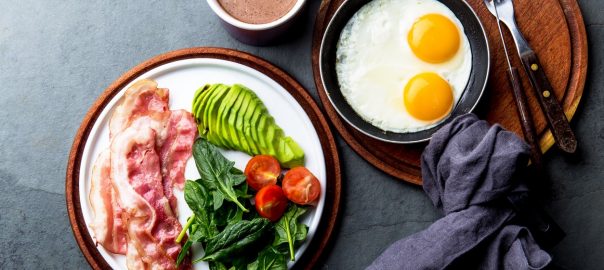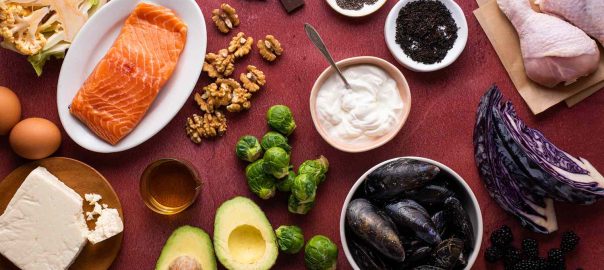Combining Keto & Fasting
Combining Two Powerful Approaches for Better Results
Intermittent fasting (IF) and the keto diet are two of the most popular and effective strategies for improving your health, losing weight, and optimizing metabolic performance. When used together, they create a synergistic effect that amplifies their benefits, helping you achieve your goals more efficiently. Below, we’ll explore how these two approaches complement each other, go over different fasting schedules, and provide practical tips to help you succeed!
The Relationship Between Intermittent Fasting and Keto
Intermittent fasting is a pattern of eating that alternates between periods of fasting and periods of eating. By restricting the window of time in which you eat every day, you’re encouraging your body to burn fat for energy, especially when glucose levels are low.
It’s important to note that intermittent fasting requires you to also abstain from many beverages. Drinks like alcohol, fruity or sugary drinks, and milks or fats should be avoided during the fasting period. You can and should still drink lots of water throughout the day, and black coffee or unsweetened tea is allowed. You can also drink sparkling water (calorie-free), bone broth, and diluted apple cider vinegar.
The keto diet focuses on high-fat, moderate-protein, and very low-carb foods, forcing your body into a metabolic state called ketosis. When your body is in ketosis, it uses fat, rather than glucose, as its primary energy source.
When combined, intermittent fasting and keto work together to:
- Enhance fat burning – Intermittent fasting accelerates the body’s shift into ketosis by depleting glycogen stores faster.
- Supress your appetite – The high-fat nature of keto naturally reduces hunger, making it easier to fast.
- Keep energy levels stable – Both approaches help to stabilize your blood sugar and reduce energy crashes, providing sustained focus and vitality throughout the day.
Learn more about combining keto and intermittent fasting.
Intermittent Fasting Schedules
Several intermittent fasting schedules can be seamlessly integrated with a keto lifestyle. The key is to try a couple out and see which one works best with your lifestyle and weight loss goals.
The 16/8 Method
- What It Is: Fast for 16 hours and eat within an 8-hour window.
- Why It Works: This popular approach is beginner-friendly and fits well into most routines. It allows your body time to enter ketosis and use fat for energy.
- The 16/8 Method in Action: Eat from 12 pm to 8 pm, fasting overnight until noon the next day.
One Meal A Day (OMAD)
- What It Is: Consume all your daily calories in one meal.
- Why It Works: One meal a day maximizes time in ketosis and is ideal for those who prefer simplicity.
- The OMAD Method in Action: Eat dinner at 6 pm, then fast until the next day’s dinner.
Alternate Day Fasting (ADF)
- What It Is: Alternate between days of normal eating and fasting or restricted calorie intake (e.g., under 500 calories).
- Why It Works: Alternate day fasting promotes deep ketosis and is highly effective for fat loss, though it can be very challenging for beginners.
5:2 Method
- What It Is: Eat normally for five days and significantly reduce calorie intake (500-600 calories) for two non-consecutive days each week.
- Why It Works: A gentler introduction to fasting, this diet complements keto by allowing more flexibility for your lifestyle while still promoting fat burning.
The Benefits of Combining Intermittent Fasting and Keto
Combining intermittent fasting and keto offer numerous potential health benefits, including:
- Accelerated weight loss – Both approaches encourage fat loss, and together, they increase calorie deficit and fat oxidation.
- Improved metabolic health – Both diets help to lower insulin levels, reducing inflammation and improving insulin sensitivity.
- Enhanced cognitive function – Ketones serve as a brain-friendly fuel, while fasting helps stimulate the production of brain-derived neurotrophic factor (BDNP), helping to improve mental clarity.
- Reduced hunger – Keto’s appetite-suppressing effects can make fasting easier, while fasting helps to regulate certain hunger hormones like ghrelin.
- Better digestion – Fasting gives the digestive system a break, helping to reduce bloating and improving gut health.
Tips for Intermittent Fasting on a Keto Diet
Combining intermittent fasting and keto require some adjustments to help ensure a smooth transition and long-term success.
- Start Gradually
Ease into fasting by first adopting a keto diet for a few weeks to help your body adapt to burning fat and intaking less carbs. Begin with a shorter fasting window, like 12/12, and gradually extend it as your body becomes comfortable.
- Stay Hydrated
Drink plenty of water throughout the day to prevent dehydration and support your metabolic processes. Additionally, you can add electrolytes into your water to replenish minerals like sodium, potassium, and magnesium. Just make sure that the electrolytes you use don’t contain added sugars or calories.
- Plan Your Meals
Focus on nutrient-dense, high-fat foods during your eating window to make sure your body is getting enough macro and micronutrients. Be sure to include healthy fats, like avocado or olive oil, moderate protein from eggs, chicken or other protein sources, and non-starchy vegetables like spinach and broccoli.
- Use Fat to Break Your Fast
Breaking your fast with a high-fat, low-carb snack like a keto smoothie or a handful of nuts can help maintain ketosis and avoid spikes in your blood sugar.
- Keep It Simple
Batch cook your meals to minimize prep time and ensure you always have keto-friendly, delicious, and nutritious options on hand when it’s time to eat.
Managing Your Hunger and Energy Levels
Fasting can initially feel very challenging, but strategic planning can help you stay energized and avoid hunger pains.
- Embrace Keto-Friendly Snacks
When hunger strikes, keep snacks like nuts, cheese, or keto protein bars on hand to provide quick fuel when your fast ends.
- Prioritize Healthy Fats
Healthy fats can help keep you satiated longer, helping to reduce cravings and hunger pains.
- Stay Busy
Distraction is key! Use your fasting periods to focus on work, hobbies, or exercise.
- Time Your Workouts
Schedule workouts during your eating window or just before breaking your fast for optimal energy and recovery.
- Listen to Your Body
If you feel excessively hungry or fatigued, shorten your fasting window, and adjust your meal plan as needed. It’s also possible that you will be able to maintain an intermittent fasting schedule most days but have a random day here or there where you are feeling faint or excessively hungry. It is okay to break your fast early on days when you need it. It is very important to listen to your body and adjust as needed.
Nutrient Considerations When Fasting on Keto
Intermittent fasting on keto requires extra attention to your nutrient intake to ensure your body gets what it needs.
Protein
Maintain a modern protein intake to help preserve muscle mass while promoting ketosis. Make sure to include quality protein sources like eggs, fish, poultry, and grass-fed beef in your meals. It’s always a good idea to mix up your protein source to make sure you’re getting all the important micronutrients in your diet too.
Fats
Focus on healthy fats like avocado, coconut oil, nuts, seeds, and fatty fish to help provide sustained energy.
Micronutrients
As mentioned above, it’s important that you’re getting enough micronutrients. Incorporate magnesium, potassium, and sodium through food or supplements to prevent electrolyte imbalances. Eating a variety of low carb vegetables will help ensure that you are getting all the essential vitamins and minerals that you need.
Some of Our Favourite Picks for Nutrient Support
Electrolyte Powders
Make sure you are replenishing key minerals that are lost during fasting.
Snack Bars
Snack bars and protein bars are a great way to fuel up on the go or in a hurry!
Nut Butters
Nut Butters are great for adding healthy fats to your meals or as a first snack when breaking your fast.
Potential Fasting Challenges and How to Overcome Them
While the combination of intermittent fasting and keto is powerful, it certainly comes with potential challenges, especially for beginners. Here is how to help overcome some of the common ones!
- The Keto Flu
Symptoms like fatigue, headaches, and irritability during the initial stages of keto.
Solution
Stay hydrated, increase your electrolyte intake, and eat enough healthy fats to help ease the transition.
- Hunger During Fasting
Persistent hunger, especially when first starting intermittent fasting. Hunger can feel different for everybody, with some people experiencing pain or nausea, or even headaches, when hungry.
Solution
Gradually increase your fasting durations, drink plenty of water, and consume high fat meals during your eating windows.
- Low Energy Levels
Feeling sluggish, particularly if fasting is combined with intense exercise.
Solution
Eat nutrient-dense meals, adjust your fasting schedule, and prioritize sleep.
- Social Pressures
Difficulty maintaining intermittent fasting and keto restrictions during social events.
Solution
Plan ahead by eating before events, bringing keto-friendly dishes, or scheduling fasting around social commitments.
- Digestive Issues
Some people can experience constipation or bloating due to their dietary changes.
Solution
Increase your fibre intake with low carb vegetables and drink plenty of water. Others can experience stomach upset if they drastically increase their fibre intake quickly. In that case, slowly increase your fibre intake, allowing your digestive tract time to adjust to this new diet.
Two Approaches for One Powerful Combination
Intermittent fasting and keto are two scientifically backed approaches that, when combined, create a powerhouse for weight loss, metabolic health, and overall wellness. By adopting a fasting schedule that fits your lifestyle, planning nutrient-dense meals, and staying mindful of your body’s needs, you can unlock the full potential of these methods and find success in your health goals.
Whether you’re new to keto, or a seasoned faster, this combination of the two approaches offers you the tools you need to thrive and meet your goals. Start today and experience the transformative synergy of intermittent fasting and keto for yourself!
Low Carb Grocery Is Here to Help
Everybody is different and every body has different needs. It’s important to try out a couple of different diets and techniques to see what works best for your lifestyle and needs.
Ultimately, the healthiest approach to eating is one that focuses on whole, minimally processed foods and allows for flexibility and moderation. As you try out different techniques to see what works best with your body, we recommend following the guidance of health care professionals who are familiar with your specific body, your activity levels, and any possible health concerns. Your body will give you cues to help you figure out what method of dieting helps you look and feel your best.
Looking for additional tips for successfully switching to low carb? Check out our low carb blog here.
Want to shop for healthy, delicious low carb groceries that arrive at your door? Check out our selection of low carb food here.
Enjoy free shipping across Canada on orders over $99. As an added bonus, customers in the Greater Toronto Area receive complimentary delivery for purchases exceeding $69.
Shopping at stores like Low Carb Grocery allow you to access a wide variety of low carb products at competitive prices. Keep an eye on sales, use loyalty programs, and take advantage of bulk purchasing to further maximize your savings.
More Low Carb Lifestyle Articles
Top Snack Foods
Discover the ultimate guide to keto and low carb snacking! We’ve compiled our favourite snacks and sweets that are both delicious and diet friendly! From chocolatey treats to savoury bites, we’ve got something for everyone!
Zero Carb Foods
Maintaining a low carb diet can be challenging, but with the right foods, it doesn’t have to be. This article is packed with product recommendations to help you stay on course. Discover how to fully embrace a keto or low carb diet with delicious meals that satisfy every craving.
Is Going Low Carb Healthy?
Interested in making the switch to a low carb diet but worried about adverse health effects? Learn more about the role that carbs play in your diet and how they affect your overall health and fitness goals to determine if a low carb diet is the right choice for you.
30 Low Carb Foods
Looking for delicious and satisfying meals that fit into your low carb lifestyle? Explore our list of 30 healthy low carb foods, including pantry staples and specialty products.
Getting Started with Keto
The keto diet, as it is commonly known, has surged in popularity due to the dramatic results that people have experienced. However, there remains some skepticism about how it works from those who are new to high-fat and high-protein eating. Learn more about this diet here.





















